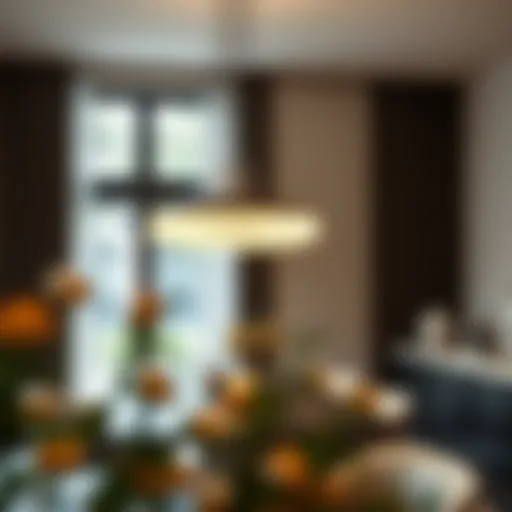Selecting Cushions for Your L-Shaped Sofa
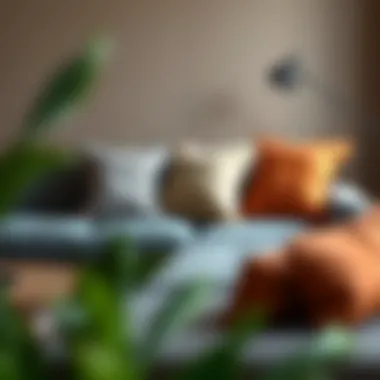

Intro
Selecting cushions for an L-shaped sofa is no small feat. It’s not just about picking something that looks good; the right cushions serve both functional and aesthetic roles. With numerous materials, shapes, and sizes available, homeowners and designers must navigate the choices carefully to harmonize comfort with style. This guide delves into essential aspects, from understanding furniture design styles to practical tips for buying and maintaining your cushions, setting the stage for a well-designed living space.
Furniture Design Styles
When it comes to cushions, the design style of your furniture offers a significant backdrop. Selecting cushions that complement or contrast with the sofa's design enhances the entire room's visual appeal. Thus, understanding various furniture styles is fundamental.
Overview of Popular Styles
- Modern: Characterized by clean lines and minimalistic forms, modern design often leans toward bold colors or subtle neutrals. Cushions with geometric patterns or textures can add a striking contrast.
- Traditional: This style embraces rich fabrics and intricate detailing. Opt for cushions in floral prints or classic patterns like plaid, made from materials such as velvet or cotton.
- Bohemian: A mix of vibrant colors, patterns, and textures dominate in Bohemian decor. Think about adding cushions with tassels, fringes, and varied prints for a personalized touch.
- Scandinavian: Known for its simplicity and functionality, Scandinavian design favors muted colors and natural materials. Cushions in soft pastels or with simple prints work wonderfully here.
- Industrial: Often featuring raw materials like metal and wood, industrial design can benefit from cushions made of leather or heavy canvas in darker hues to create an inviting feel.
How to Mix and Match Styles
Mixing styles can seem risky, but it often results in a captivating aesthetic if done thoughtfully. Here are a few pointers:
- Find a Common Element: Use a unifying color or pattern among various cushions to create coherence.
- Varying Shapes and Sizes: Mix square and rectangular cushions, along with round ones, to add depth and interest without overcrowding the space.
- Contrasting Textures: Pair soft, plush cushions with denser, structured ones to maintain balance and invite touch.
- Layering Colors: Use a base of neutral tones and let bold hues or patterns pop within the mix.
Practical Tips for Homeowners
Choosing cushions involves not just style considerations; practicality must also come into play. Here are some essential guidelines.
Essential Buying Tips
- Think about Use: Consider how often the sofa is used. For heavy usage, opt for durable fabrics like polyester or canvas.
- Size Matters: Measure the cushions to ensure they fit well on the sofa without overwhelming its proportions.
- Shape Dynamics: Remember that square cushions are versatile, while rectangular ones can support different arrangements or provide added comfort when lounging back.
- Ask About Fill: With options like down, polyester, or foam, don’t hesitate to request firmness levels suited to your comfort.
Maintenance and Care Guidelines
Cushions are prone to wear and tear, so maintaining them is key to longevity.
- Regular Cleaning: Most cushions require vacuuming at least once a week to remove dust. Some may be machine washable—check the care labels!
- Fluff Often: Give them a good fluff to maintain their shape. This helps avoid flattening and ensures comfort.
- Rotate Cushions: Regularly rotate your cushions to distribute wear evenly and offset fading from sunlight.
- Use Protective Covers: If pets or kids are around, using removable covers can help keep them looking sharp with minimal effort.
"Selecting cushions is not only about aesthetics, it’s about how those choices fit into your daily life."
By applying these principles, selecting the right cushions for your L-shaped sofa can become an enjoyable challenge rather than a daunting task. Those who grasp these nuances can breathe life and style into their spaces—proving that comfort and design can indeed go hand in hand.
For additional insights, consider visiting Wikipedia: Interior Design or check communities on Reddit for discussions about fostering style in living spaces.
Understanding the Importance of Cushions
When it comes to L-shaped sofas, the choice of cushions isn't just a trivial matter; it's the linchpin that combines comfort and style. Cushions play a fundamental role, enhancing your space both physically and visually. They are more than mere accessories; they are integral elements that can transform your living area from mundane to magnificent.
Cushions as Functional Elements
Cushions serve practical purposes that are often overlooked. First and foremost, they provide comfort. An L-shaped sofa, while spacious, can sometimes feel overwhelming or too firm without the right cushions. These pillows not only support your back and neck but also encourage relaxation, which is invaluable, especially after a long day.
Furthermore, cushions can help define seating areas. In an open concept space, for example, a thoughtfully arranged selection of cushions can visually segregate the sofa from the surrounding space, creating a cozy nook that beckons you to sit and unwind. The correct cushion density and size can enhance the usability of your sofa, providing firm support for formal seating while also allowing for a plush, relaxed feel for leisurely lounging.
"Choosing the right cushions can redefine a space, making it both functional and inviting."
Additionally, consider how they affect ergonomics. The right cushions can align your posture correctly, preventing discomfort during extended periods of use. For that reason alone, selecting cushions tailored to your specific needs deserves serious thought.
Aesthetic Contributions to Interior Design
From an aesthetic standpoint, cushions are the cherries on top of your design sundae. They offer one of the simplest ways to add pops of color, texture, and personality to your decor scheme. The choice of fabrics and colors can either harmonize with or contrast against your sofa, creating exciting visual dynamics.
An eye-catching cushion can also serve as a focal point in your living room. Think of it as a piece of art; a vibrant velvet cushion nestled against a muted fabric can create intrigue. When you welcome guests into your home, it’s those special touches that they notice first. It's not just about coordination but about creativity and daring choices.
Moreover, cushions can reflect personal style. Whether you lean towards rustic charm with patterned or textured fabrics or prefer a sleek modern aesthetic with bold solids, your cushion choices signal your design philosophy. It’s a simple way to express individuality within your space that reinforces your overall design narrative.
In summary, understanding the importance of cushions in the context of an L-shaped sofa brings both functional benefits and aesthetic enhancements. Selecting the right combination allows you to elevate comfort and style, creating a cohesive and inviting environment.
Exploring Cushion Shapes
Choosing the right cushion shape for your L-shaped sofa can greatly influence both comfort and style in your living space. Different shapes cater to various functional needs while also enhancing the aesthetic appeal of your room. As you plan your cushion selection, consider how shape interacts with size, design, and comfort level. This section explores the three predominant cushion shapes: square, rectangular, and custom options. Understanding these shapes will help in making an informed choice that aligns with your overall design vision.
Square Cushions: Classic and Versatile
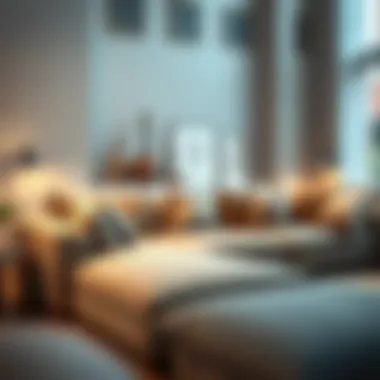

Square cushions are often considered the quintessential pieces for any seating arrangement, and for good reason. They offer a straightforward, symmetrical look that can complement nearly any style of interior decor. Their classic design allows for endless versatility, making them suitable for modern, rustic, and even eclectic settings.
When upholstered with inviting fabrics, square cushions deliver not just comfort but also a sense of harmony. If you aim for a peaceful and cohesive feel, don’t shy away from sticking with solid colors or subtle patterns that echo the colors in your sofa.
Moreover, square cushions work exceptionally well as accent pieces. Pairing larger cushions with smaller ones creates a balance that adds depth to your sofa arrangement. As an added benefit, they are often easier to maintain because of their uniform shape, ensuring they fit snugly in pillow covers for cleaning purposes.
Rectangular Cushions: Adding Support and Style
Rectangular cushions, sometimes referred to as lumbar cushions, serve a dual purpose—providing comfort and elegant styling. These cushions are especially beneficial for enhancing back support, which can be crucial during long periods of sitting. Because they are generally longer than they are wide, they fit perfectly in the natural curvature of your lower back, mitigating any discomfort.
In terms of design, rectangular cushions can help elongate the visual lines of your L-shaped sofa. This can create a sophisticated look, drawing attention to the sofa’s unique shape without overwhelming it. Opt for fabrics that contrast or match the hues of your sofa. Using complementary colors can work wonders in elevating your overall decor.
Moreover, an interesting trick many decorators use is layering rectangular cushions in front of square ones. This arrangement not only enhances comfort but also adds a stylish flair to your setup. Choosing cushions with varied textures can also introduce visual variety while maintaining that desired comfortable vibe.
Custom Shapes: Tailoring to Your Design Vision
For those who wish to venture beyond traditional cushion forms, custom-shaped cushions offer a world of possibilities. Tailored to fit specific themes and personal tastes, these cushions might come in unique silhouettes—from rounded to quirky, abstract shapes. This level of customization allows you to express your creativity and enhance the character of your living space.
Custom cushions can be especially beneficial in maximizing corner spaces of an L-shaped sofa, where traditional shapes might not fit flawlessly. An organically shaped cushion can conform to your body, offering unparalleled comfort that standard shapes may lack.
Consider the material and color carefully when opting for custom styles. A bold, avant-garde shape in a neutral tone can add a touch of whimsy without overloading the senses. On the other hand, a custom cushion patterned with vibrant designs might quickly become a centerpiece in your living area.
In summary, exploring cushion shapes is not just about aesthetics; it's about functional comfort and personal expression. By implementing a thoughtful approach to cushion selection, you can significantly enhance the enjoyment of your L-shaped sofa. Each shape serves a purpose, and when combined strategically, they can transform a simple seating arrangement into a sophisticated and inviting area.
Cushion Sizes and Their Impact
When selecting cushions for your L-shaped sofa, size is a significant factor that often goes overlooked. An inappropriate cushion size can compromise not only the sofa's comfort but also its aesthetic appeal. Understanding how cushion sizes affect your seating arrangement can guide your choices, ensuring that both form and function meet harmoniously.
Proportions for Comfort
The comfort level of your seating is directly influenced by the sizes of the cushions you choose. Cushions that are too large can overwhelm a petite sofa or make it uncomfortable to sit on, while cushions that are too small might make it seem sparse and uninviting. The trick lies in achieving perfect proportions.
- Balance is Key: If your sofa has a minimalist design, slim cushions can enhance that sleekness. Conversely, oversized cushions can inject warmth and coziness into a more contemporary frame.
- Incorporate User Preferences: Consider the height and depth of your seating. For instance, if you find yourself slumping into the cushions, opting for firmer, thicker cushions can provide the necessary support.
- Test the Waters: It’s always beneficial to experiment with different cushion sizes. Arrange a few on the sofa during a leisurely weekend. Sometimes, taking a step back and analyzing how they complement the overall look will give you a better perspective.
Layering Sizes for Depth
This is where creativity plays a vital role. Layering different size cushions is not just a design choice; it adds depth and intrigue to your sofa's appearance.
- Mix and Match: No need to feel boxed in by uniformity. Combining square cushions with rectangular and even bolster shapes can break visual monotony and lend a dynamic feel.
- Comforting Chaos: Don’t be shy about creating a bit of chaos with size—this allows for a more relaxed, lived-in feel. When done right, layered sizes can draw the eye and invite people to sit down and enjoy.
- Consider Scale: While layering, keep in mind the scale of your sofa and room. Larger rooms can handle bigger cushions, while smaller spaces might benefit from a more restrained approach.
The key takeaway here is that the right cushion sizes not only bolster the comfort of your L-shaped sofa but also amplify the overall aesthetic, guiding the eye and enhancing the space.
Material Choices for Cushions
When diving into the realm of cushion selection, the materials that make up those soft, inviting pillows play a pivotal role in terms of performance, comfort, and overall aesthetic. Understanding the various options helps you make an informed choice that not only complements the design of your L-shaped sofa but also meets the practical needs of your lifestyle. Choosing the right materials can enhance durability, ease of maintenance, and provide the cozy feel you desire in your seating arrangement.
Fabric Options: Exploring Texture and Durability
The variety of fabrics available for cushions is astounding, each with its own set of characteristics contributing to both comfort and durability. When you look at options like linen, cotton, or synthetic fibers, consider how they resonate with your home environment. For instance, linen adds a touch of elegance but can wrinkle easily, while cotton offers a soft touch yet is prone to staining without proper treatment.
A Few Key Fabric Types:
- Cotton: Breathable and easy to clean, it’s a popular choice for households with children or pets.
- Linen: Known for its luxurious feel and natural imperfections; a great choice for sophisticated spaces.
- Polyester: Often blended with cotton, it’s resistant to fading and cleaning hassle, ideal for casual settings.
- Velvet: Delivers an upscale look, but may require more careful handling to maintain its plush texture.
The interaction between texture and durability should guide your decision. A richly textured fabric can elevate a space, but ensure that it aligns with your daily usage—nobody wants a beautiful cushion that can't handle its share of wear and tear.
Foam and Fill Type: Comfort and Support
While the outer layer of fabric catches the eye, the magic often lies within the cushion—specifically, the type of foam or fill used. This inner composition significantly influences how your cushions perform in terms of comfort and longevity.
Common Fill Types:
- Polyurethane Foam: Lightweight and versatile, this foam offers varying densities, catering to different comfort preferences.
- Memory Foam: Known for its contouring properties, it provides excellent support but might feel warmer due to its density.
- Down/Feather: Offers unparalleled softness and a plush feel but requires regular fluffing to maintain shape.
- Synthetic Blends: These are designed to mimic the softness of down while ensuring ease of care, making them a go-to for versatile modern homes.
Selecting the appropriate foam density is crucial. A firmer cushion might provide better back support, while softer options invite you to sink in and relax. Consider your seating habits: do you prefer lounging for hours, or are you more inclined to keep it formal and upright?
Proper choices for both fabric and fill type ensure that your cushions aren't just eye candy; they support quality lounging experiences.
Taking the time to evaluate material options, from fabric textures to internal fills, can elevate the comfort and appeal of your L-shaped sofa. When you craft a harmonious blend of aesthetics and function, you achieve not just a stylish look, but a set of cushions tailored to your needs.
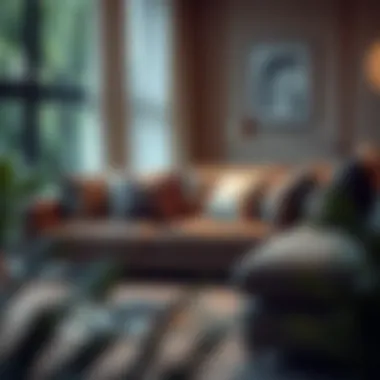

Choosing Colors and Patterns
Selecting the right colors and patterns for your cushions can make or break the look of your L-shaped sofa. This section dives into why colors and patterns matter, and how you can use them to elevate your space. The right choices here can result in a harmonious environment that feels intentional and well-considered.
Establishing Harmony with Your Sofa
When considering the colors for your cushions, it’s essential to think about harmony with the existing color scheme of your sofa. An L-shaped sofa often acts as the centerpiece of a room, so your cushion choices should complement its hue, texture, and architectural elements. For instance, if your sofa is a deep charcoal, introducing cushions of lighter tones like cream or soft grey can create a lovely contrast. Conversely, if your sofa is a lighter shade, perhaps in beige or soft blue, bold colors like deep plum or forest green might call attention effectively without clashing.
Moreover, think about the materials involved. If your sofa has a velvety finish, the texture of your cushions should mirror that softness. Smooth cotton cushions may create a jarring effect against a plush fabric. To establish that coveted visual cohesion, consider a color wheel for guidance on complementary colors but feel free to approach it more as a suggestion rather than a strict rule—after all, home decor is about personal expression.
Creating Visual Interest with Patterns
Patterns can inject life into your cushion arrangement and add depth to the overall design. If you’re going for a bold, adventurous look, don’t shy away from mixing patterns. Stripes, florals, and geometric prints can coexist beautifully; just ensure that the color scheme ties them together. For instance, if you have a floral cushion featuring shades of your navy sofa, adding a striped cushion that incorporates a little of that navy can harmonize these different styles perfectly.
It’s useful to consider the scale of the patterns as you design your arrangement. Large-scale patterns work well as a statement piece, while smaller patterns can serve to add details without overwhelming. For example, pair a big floral print with smaller polka dots or stripes in similar hues—this can create a layered effect that is visually engaging yet not chaotic.
"Patterns should tell a story, adding individual character while enhancing the overall atmosphere of the room."
When layering cushions on your L-shaped sofa, strike balance. Too many complex patterns could lead to a dizzying effect; conversely, a single patterned cushion in a sea of solids can fall flat.
Epilogue
Ultimately, finding the right colors and patterns for your cushions is about balancing contrast and harmony. With thoughtfulness in your selections, your cushions can create a sophisticated look that reflects your personal style while ensuring your L-shaped sofa remains a welcoming focal point of your living space.
For additional insights on color theory and patterns in interior design, consider visiting Encyclopedia Britannica or joining discussions on platforms like Reddit. Conducting research like this can help refine your choices, enhancing your decor's overall sophistication.
Cushion Arrangement Techniques
Understanding how to arrange cushions on your L-shaped sofa is much more than just aesthetics; it's about enhancing comfort, creating focal points, and ensuring your space feels inviting. The way you position cushions can dramatically affect the overall look and user experience of your living area. It’s not just about plopping on a few random cushions; thoughtful arrangements can bring both functionality and style together, tailored for every occasion.
Layering for Depth: The Art of Arrangement
Layering cushions is akin to mixing colors on a palette; it's about finding that balance between variety and unity. By varying sizes and textures, you can create an appealing visual depth that invites relaxation. For example, begin with larger cushions at the back, which offer support and a foundation. Then, progressively layer smaller, more textured cushions at the front. This contrast not only showcases the pillows themselves but also creates a cozy environment that encourages lounging.
To achieve this look, consider using a mix of:
- Square cushions for backbone support.
- Rectangular cushions for anatomical comfort.
- Textured cushions for visual intrigue.
Remember, it’s essential to experiment with different arrangements. Move cushions around until you find an arrangement that not only looks right but feels right. No two sofas are the same, so trust your instincts.
Symmetrical vs. Asymmetrical Layouts
Choosing between symmetrical and asymmetrical arrangements can dictate the mood of your living space. Symmetry can evoke a sense of order and calm; think about matching cushion types and colors on either side of the sofa. This classic layout works well in traditional or formal settings, presenting an air of sophistication. You might place two identical square pillows on each end and add a couple of accent cushions in the middle.
Asymmetry, on the other hand, expresses a more relaxed, modern vibe. This approach allows for greater freedom in selecting cushion shapes and colors, inviting creative expression. For instance, consider mixing large and small cushions in varied patterns, but ensure they maintain a cohesive color palette. An example might be a large, bold-patterned cushion on one end, complemented by several smaller cushions in coordinating solid colors.
"In arranging cushions, balance isn't always about symmetry; sometimes, the beauty lies in the unexpected."
Ultimately, the choice between these layouts should reflect your personal style and how you intend to use the space. Whether you prefer the structured elegance of symmetry or the playful charm of asymmetry, understanding the impact each choice has will guide you toward creative yet practical decisions.
Practical Maintenance Tips
When selecting cushions for your L-shaped sofa, it's not just about aesthetics or comfort; practicality plays a central role too. Proper maintenance can extend the life of your cushions and enhance your overall experience of the sofa. The materials used, the construction, and even your lifestyle choices can influence how often and in what ways you’ll need to care for your cushions.
Understanding the ins and outs of cushioning maintenance is crucial for homeowners and designers alike. Over time, dirt, odors, and wear can take a toll. By adopting regular care strategies, you not only keep the appearance of your cushions fresh but also ensure that they remain comfortable and supportive, enriching the overall ambiance of your living space.
Cleaning Techniques for Different Materials
Cushions come in a variety of materials, and cleaning methods can differ significantly based on these. Here’s a quick rundown of some common materials and how best to clean them:
- Cotton or Linen: These natural fibers can usually be machine washed. However, always check for care labeling. If machine washing isn’t an option, spot cleaning with a mild detergent and water can be effective.
- Polyester or Synthetic Fabrics: These materials are often stain-resistant and can sometimes withstand machine washing. For tough stains, a mixture of vinegar and water can work wonders.
- Leather or Faux Leather: A damp cloth is often enough to clean these surfaces. For deeper cleaning, use specialized leather cleaners, but avoid harsh chemicals.
- Microfiber: This material is known for its durability. Typically, a vacuum or a gentle wipe with a cloth should keep it looking sharp. For stubborn stains, a tiny bit of soapy water may help.
"The right cleaning method can prevent wear and tear while keeping your cushions looking good as new."
Knowing the right techniques ensures your cushions not only look appealing but also maintain their integrity over time.
Preserving Shape and Comfort
Once you’ve selected the right cushions, maintaining their shape and comfort is vital. Cushions can flatten or lose their supportive qualities over time, affecting how they feel when you sit or lay down.
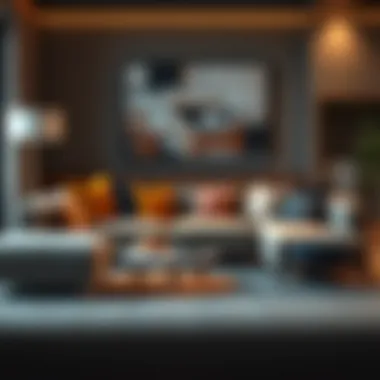

- Fluff Regularly: Make it a habit to fluff your cushions often. This encourages even wear and helps in maintaining their original shape. Fluffing can be as simple as kneading and reshaping them with your hands.
- Rotate Often: If you have multiple cushions, rotating them not only promotes even wear but also gives them time to bounce back in a different position. This adds longevity to their life.
- Use Cushion Covers: Investing in cushion covers can provide an extra layer of protection. They are often machine washable and can help in preserving the original fabric underneath.
Taking these precautions means your cushions will remain plush and comfortable, ensuring that your L-shaped sofa is an inviting spot for years to come.
For further reference on maintaining cushions and other furniture care tips, visit the following links:
Wikipedia on Upholstery
House Beautiful for Cleaning Tips
Reddit Community Discussions on Cushion Care
By adhering to these maintenance tips, you can significantly enhance the lifespan of your cushions while keeping them in excellent shape. This attention to care helps in upholding not just the appearance, but also the comfort of your treasured living space.
Viewing Current Trends in Cushion Design
In the ever-evolving world of interior design, trends influence not just aesthetics but also functionality. When it comes to cushions for L-shaped sofas, staying attuned to current trends is essential, as it can significantly impact the overall look and feel of your living space. As styles ebb and flow, cushions have become more than mere accessories; they embody lifestyle choices that resonate with today's consumers.
Sustainable Materials and Eco-Friendly Choices
Sustainability has taken center stage in recent years, and this notion is echoing loudly within the realm of cushion design. Consumers are increasingly expressing their values through their choices, opting for cushions that are made from sustainable materials. Think organic cotton, linen, or even recycled polyester. Not only do these fabrics often come with a softer touch, but they also present a reduced environmental footprint compared to conventional materials.
When selecting cushions, one can look for certifications like OEKO-TEX, which assures that textiles are free from harmful chemicals. Choosing cushions with such ratings not only guarantees quality but also signals to the world that a homeowner prioritizes health and the environment. Moreover, brands focused on sustainable production often utilize innovative methods, such as utilizing leftover materials from other manufacturing processes, thus reducing waste.
"In a world where everything is fast-paced, opting for eco-friendly options can ground one’s decor choices in a purpose that transcends mere style."
Integrating Technology: Innovative Cushion Designs
As technology continues to advance, it makes its way into the realm of textile design, particularly in cushions. From memory foam that conforms perfectly to the human body to temperature-regulating fabrics, these innovations can turn a simple cushion into a solution for comfort and support. Consider cushions with built-in heating elements or cooling gels that adapt to the season or even your mood. This blend of comfort and cutting-edge technology is catching the eye of many homeowners and designers alike.
Incorporating cushions with smart features allows for a tailored experience. Some modern cushions even offer adjustable fill levels, catering to different preferences for support. Such innovations are not just about luxury; they aim at enhancing well-being, making everyday life that little bit more comfortable.
In summary, being aware of current trends in cushion design, particularly regarding sustainable materials and technological innovations, facilitates informed decisions. This knowledge empowers homeowners and designers to curate spaces that are not just visually appealing, but also environmentally friendly and prepare for the future.
Cross-Compatibility with Other Furniture
When it comes to decorating a living space, the synergy between your L-shaped sofa and surrounding furniture is key. This concept of cross-compatibility delves into how cushions can enhance not just the sofa itself but the entire room. Choosing the right cushions means thinking beyond mere aesthetics; it's about establishing a harmonious relationship between all the pieces of your décor.
Cohesion with Surrounding Elements
Consider this: a room cluttered with mismatched items can make even the most elegant L-shaped sofa feel out of place. Cohesion with surrounding furniture refers to how well your chosen cushions tie in with the other elements like armchairs, coffee tables, and even side lamps.
- Color Palette: Cushions should resonate with the color scheme of the space. If you’ve got a neutral sofa, bright patterned cushions can make a bold statement, while muted tones can create calm.
- Material Consistency: Textures matter. Mixing leather, polyester, and cotton in an arbitrary manner can be visually jarring. Instead, consider whether your cushions align with the materials of nearby furniture. For instance, a leather armchair might pair well with smooth, polished cushions while a fabric sofa may complement textured ones.
- Style Matching: Does your furniture speak a modern language or lean toward classic? Matching the style of your cushions to that of the surrounding décor ensures that everything looks pulled together. A contemporary sofa can feel uninviting with traditional floral cushions; likewise, minimalist cushions might clash with ornate antique furniture.
"Cohesion isn’t just about looks; it’s about creating a narrative through visually complementary elements in your space."
Upgrade Considerations for Transitional Spaces
As we move through life, our needs change, and so does our living space. In transitional areas, where function often meets style, selecting the right cushions becomes critical. This upgrade consideration looks at how to make your cushions work for areas that commonly get overlooked during decor updates.
For example, if your L-shaped sofa adjoins a dining room or flexible guest space, versatility is paramount.
- Multi-Functionality: Think about cushions that can serve multiple purposes. A cushion that looks good on the sofa but can also double as a comfortable backrest for guests sitting nearby is a smart choice.
- Seasonal Adjustments: In transitional spaces, seasonal trends might swing your way. You may want to store heavier, darker-colored cushions after winter in favor of lighter fabrics and colors in the summer, giving your sofa a fresh vibe without a complete overhaul.
- Weight Consideration: In spaces that transition from casual gatherings to formal ones, opt for cushions that can be easily moved or rearranged. Heavier, dense cushions may be superb for comfort but can hinder that spontaneous reconfiguration when hosting impromptu gatherings.
In summary, understanding cross-compatibility helps in building a cohesive and adaptable living environment. By keeping cushions aligned with the dynamics of surrounding furniture, you can effortlessly create spaces that are not only visually appealing but also functionally sound.
Budgeting for Quality Cushions
When it comes to decorating your living space, the right cushions can elevate an L-shaped sofa from being just a piece of furniture to a cozy, inviting focal point. However, before you jump into selecting every pattern and color under the sun, it’s important to understand the concept of budgeting for quality cushions. It’s not just about picking the cheapest options available; it’s about finding the right balance between quality and price that suits your needs while enhancing the overall aesthetics of your room.
Determining Value vs. Cost
In the realm of interior design, understanding the difference between value and cost is crucial. Cost refers to the price you pay for a cushion, whereas value embodies the overall benefit it brings to your space.
When determining what you should pay for cushions, consider the following factors:
- Material: High-quality fabrics like velvet or high-thread-count cotton might come with a steeper price tag but offer durability and comfort.
- Construction: Well-stitched, durable seams can prevent rips or loss of shape over time. Investing in construction quality can save you money in the long run.
- Functionality: Think about how the cushions will be used. If they’re for living spaces with heavy traffic, a sturdier cushion may be worth the investment to ensure longevity.
Ultimately, it’s about choosing cushions that balance your vision with your bank account. Sometimes that means spending a bit more upfront for cushions that will withstand the test of time.
Balancing Luxury and Practicality
Finding that sweet spot between luxury and practicality can be a tricky endeavor. Many homeowners desire elegant and lavish designs while also wanting items that fit within their lifestyle.
To strike this balance:
- Prioritize Key Pieces: Identify which cushions are the cornerstones of your design. Feature cushions that stand out can embody luxury, while more functional cushions provide everyday comfort.
- Mix and Match: It doesn’t have to be all-or-nothing. Combine a few luxurious cushions with basic ones to achieve a layered look without breaking the bank. This way, opulence can coexist with practicality.
- Seasonal Swaps: If your budget doesn’t allow for multiple high-end cushions at once, consider seasonal updates. Invest in a few quality pieces now and rotate with budget-friendly options as needed.
"Quality over quantity – a philosophy well worth considering when choosing cushions for your home."
In the end, budgeting for quality cushions is a puzzle where every piece needs to contribute to the larger picture. Carefully evaluating both value and cost will guide you towards cushions that not only complement your L-shaped sofa but also enhance your living space as a whole.









